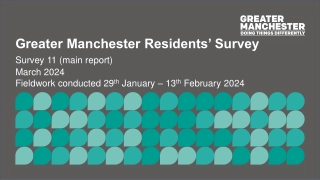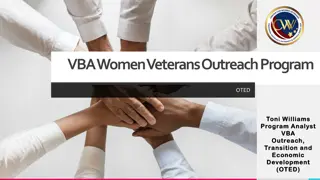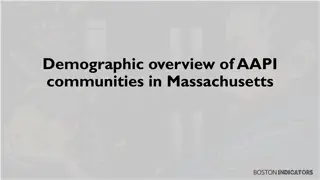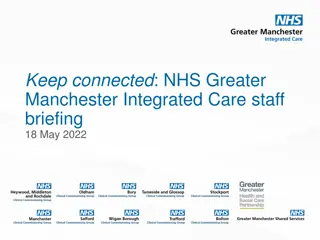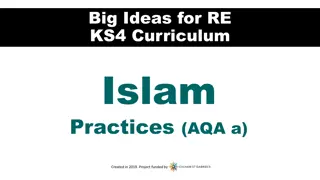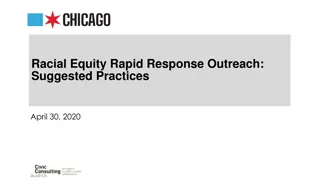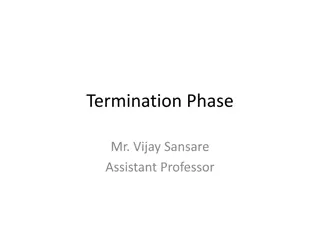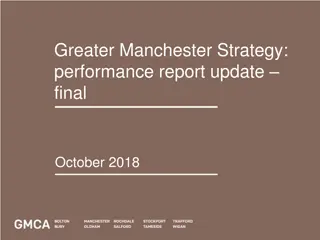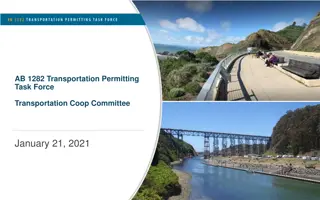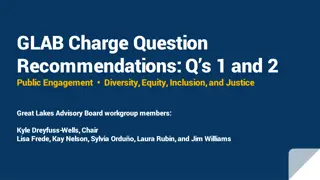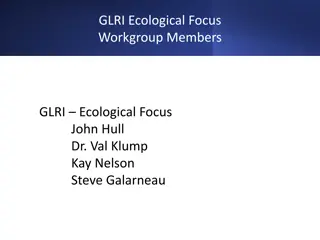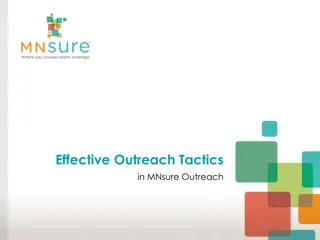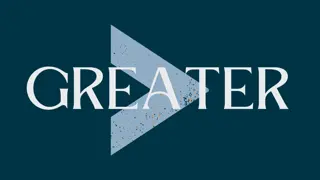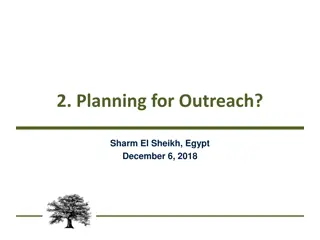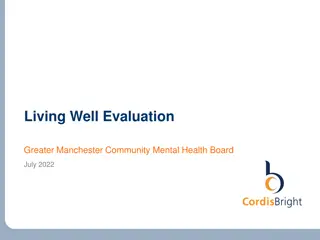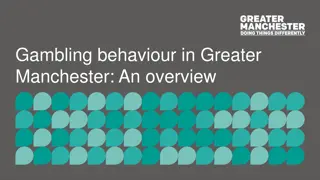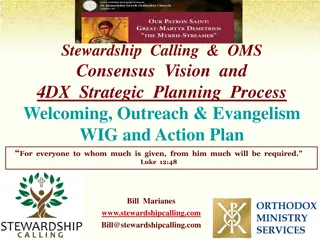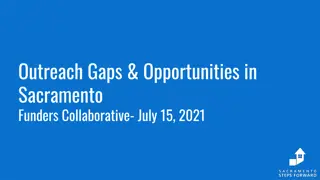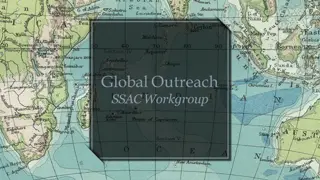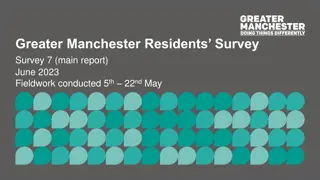GLRI Work Group Recommendations for Greater Outreach Success
This content highlights the recommendations of the EPA Great Lakes Advisory Board's GLRI Work Group on enhancing outreach for the Great Lakes Restoration Initiative. The focus is on improving communication, engaging stakeholders, and managing expectations to effectively convey the goals and accomplishments of GLRI. The recommendations include increasing visibility, engaging disadvantaged communities, and managing stakeholder expectations through clear communication strategies.
Download Presentation

Please find below an Image/Link to download the presentation.
The content on the website is provided AS IS for your information and personal use only. It may not be sold, licensed, or shared on other websites without obtaining consent from the author.If you encounter any issues during the download, it is possible that the publisher has removed the file from their server.
You are allowed to download the files provided on this website for personal or commercial use, subject to the condition that they are used lawfully. All files are the property of their respective owners.
The content on the website is provided AS IS for your information and personal use only. It may not be sold, licensed, or shared on other websites without obtaining consent from the author.
E N D
Presentation Transcript
EPA Great Lakes Advisory Board Great Lakes Restoration Initiative (GLRI) Work Group Recommendations Chairman James Williams, Sylvia Ordu o, Frank Ettawageshik, Laura Rubin Community Focus Themes: 3, 5 and 6
Theme 3: Seek Advice and Recommendations on GLRI Outreach (1 of 3) Charge Question to GLAB: How well are EPA and its federal, state and tribal partners communicating the goals, challenges and accomplishments of GLRI? Are there stakeholder groups that could be more effectively communicated with? What additional and/or innovative tools could be used to improve outreach to citizens, elected officials and partners? Recommendations: 1. Increase GLRI visibility and recognition among the general public and stakeholder communities a. Better promote GLRI initiatives and accomplishments. b. Require GLRI branding (such as a logo) on GLRI initiatives and products. c. Establish metrics and and measure outreach initiatives. d. Conduct a communications audit to identify current communication methods and media, budget, audiences, and gaps to determine, especially, whether target communities are reached. e. Tactics could include requiring a community engagement component in all grants (strategy, timeline, budget requirements in all proposals); funding and engaging public advisory councils; deploying culturally fluent EPA community liaisons; creating a low-barrier grant application process; and defining outcomes and measures for community engagement. 2
Theme 3: Seek Advice and Recommendations on GLRI Outreach (2 of 3) Charge Question to GLAB: How well are EPA and its federal, state and tribal partners communicating the goals, challenges and accomplishments of GLRI? Are there stakeholder groups that could be more effectively communicated with? What additional and/or innovative tools could be used to improve outreach to citizens, elected officials and partners? 2. Effectively engage stakeholders, paying special attention to communities affected by environmental justice (EJ) concerns a. Invite stakeholder participation from the beginning of any initiative. b. Ensure communication is two-way through meaningful engagement. c. Provide for multilingual communication. d. Intentionally identify and target remoted or often-overlooked stakeholders who have not yet been reached (e.g., disadvantaged communities, First Nations, environmental justice entities). e. Tactics could include engaging new voices to share accomplishments (e.g., youth, those impacted by AOC); identifying ways to reach defined audiences, such as messaging through mass and social media; greater use of LAMPs. 3
Theme 3: Seek Advice and Recommendations on GLRI Outreach (3 of 3) Charge Question to GLAB: How well are EPA and its federal, state and tribal partners communicating the goals, challenges and accomplishments of GLRI? Are there stakeholder groups that could be more effectively communicated with? What additional and/or innovative tools could be used to improve outreach to citizens, elected officials and partners? 3. Manage stakeholder expectations Clearly communicate to stakeholders how EPA defines restoration in each case. Ensure stakeholders understand pace of restoration (i.e., it s slow and expensive; we need scientific data to create solutions). Ensure stakeholders understand GLRI scope, goals, and challenges. a. b. c. 4
Theme 5: Outcome-Based Investments in the Great Lakes (1 of 4) Charge Question to GLAB: As we enter the next decade of GLRI funding, what are appropriate annual ecological and community-based outcomes (coupled with appropriate baselines and monitoring) to show that we are making progress in the areas of AOC remediation and delisting, invasive species control and prevention, nutrient reduction, and habitat restoration and protection, such that we can show a good return on investment? Recommendations: 1. Measure success in a variety of ways Use scientific indicators to measure outcomes. Include outcome measures that are defined by and relevant to local communities, not only to EPA experts. Integrate and advance scientific indicators, monitoring, and assessment into projects to employ the principles of adaptive management and communicate results from GLRI investments. Incorporate environmental justice and climate justice indicators and measures. a. b. c. d. 5
Theme 5: Outcome-Based Investments in the Great Lakes (2 of 4) Charge Question to GLAB: How well are EPA and its federal, state and tribal partners communicating the goals, challenges and accomplishments of GLRI? Are there stakeholder groups that could be more effectively communicated with? What additional and/or innovative tools could be used to improve outreach to citizens, elected officials and partners? 2. Invest long-term Commit to identifying new Areas of Concern (AOC) as well as addressing legacy AOCs. Commit to moving from restoration to protection and prevention. a. b. 6
Theme 5: Outcome-Based Investments in the Great Lakes (3 of 4) Charge Question to GLAB: How well are EPA and its federal, state and tribal partners communicating the goals, challenges and accomplishments of GLRI? Are there stakeholder groups that could be more effectively communicated with? What additional and/or innovative tools could be used to improve outreach to citizens, elected officials and partners? Recommendations: Ecological and community-based outcomes and baseline data Areas of Concern AOCs delisted o Consider EJ community impacts in remediation disposal locations o New or exacerbated concerns with monitoring and management? Beneficial Use Impairments (BUI) removed Management Action Lists for BUI removal Complex AOCs making progress on all AOCs Local workforce development or MWB contracts Increased public access and/or recreational benefits Invasive Species Current number of invasive species Prevention measures against new species Management measures for existing species Impacts of climate change on invasive species management Expand Legacy Act to include all contaminated sites in the Great Lakes. 7
Theme 5: Outcome-Based Investments in the Great Lakes (4 of 4) Charge Question to GLAB: How well are EPA and its federal, state and tribal partners communicating the goals, challenges and accomplishments of GLRI? Are there stakeholder groups that could be more effectively communicated with? What additional and/or innovative tools could be used to improve outreach to citizens, elected officials and partners? Recommendations: Ecological and community-based outcomes and baseline data (cont.) Nutrient Reduction and HABs Nearshore monitoring of nutrients Lake or sub-lake models Climate models and impacts on nutrients o Nexus of water, food and energy o Sustainable communities Access to clean water o Beaches are open more often o Harmful Algal Blooms (HAB) are greatly reduced o Lower costs for drinking water treatment Habitat Restoration Coastal conditions Resilience Hardening of shorelines Coastal wetlands Habitat Protection Investments in protecting habitat in concert with restoring habitats Access to restoration projects 8
Theme 6: GLRIs Role in the Vitality and Reinvestment of Great Lakes Communities Charge Question to GLAB: How can GLRI projects and funding be further leveraged across Federal agencies and programs, including Opportunity Zones and Brownfields, to maximize environmental and economic benefits to Great Lakes communities? Recommendations 1. Leverage GLRI funds by expanding the outcomes beyond simply environmental to public health, economic, and community benefits. 2. Develop models and outcomes that include not only ecosystem dynamics but also policy, public health, and economic forces. 3. Leverage other funds and prioritize projects that address climate and EJ impacted communities. 4. Assess impacts of climate change on the Great Lakes Basin that affect environmental and economic benefits, including droughts and floods. 9
Thank you We welcome your questions and comments 10



